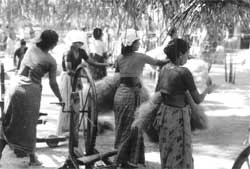Rise of a fabric
 the coir industry of Kerala, spread over the coastal areas of Alappuzha, Kollam, Ernakulam and Thiruvananthpuram districts, has been facing odds since early '60s. But thanks to the new environment consciousness emerging among western consumers, this troubled industry now pins its hopes on the increasing demand for coir abroad, as a natural bio-degradable fibre.
the coir industry of Kerala, spread over the coastal areas of Alappuzha, Kollam, Ernakulam and Thiruvananthpuram districts, has been facing odds since early '60s. But thanks to the new environment consciousness emerging among western consumers, this troubled industry now pins its hopes on the increasing demand for coir abroad, as a natural bio-degradable fibre.
One of the several reasons attributed to the decline of the Indian coir industry, as P Ajith Kumar, development officer in Coir Board of India, says is "the severe competition that our coir industry has to face from plastic and other synthetic products'. While Indian industry lagged behind due to outdated production methods, Sri Lanka succeeded in providing better quality yarn and coir fibre in the world market, with the modernisation of their coir industry.
Now, the Indian coir industry seems to have woken up to a perspective change. Kerela State Electronics Development Corporation (keltron) alone has supplied about 4,000 motorised coir spinning ratts to the state coir federation. Also product diversification and production of more value added goods has gained momentum.
In the past, retting of coconut husk took six to 10 months, polluted the backwaters and wetlands. The Central Coir Research Institute at Alappuzha, the research and development wing of coir board, has now come up with a new product called
Related Content
- State of the climate in the South-West Pacific 2022
- Budget 2013-2014: speech of P. Chidambaram, Minister of Finance
- Climate change adaptation and vulnerability assessment of water resources systems in developing countries: A generalized framework and a feasibility study in Bangladesh
- Eyewitness: Radioactivity doesn't stop at the mines in Jaduguda
- Fire tragedy
- A dying craft
